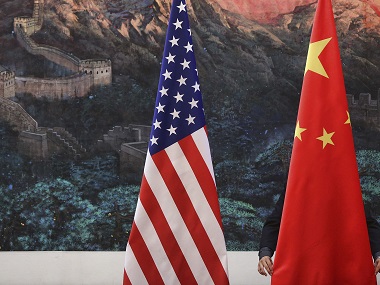The ongoing trade war between the US and China now covers the majority of the bilateral trade between the two countries. The futility and fatality of the series of retaliatory tariffs cannot be overemphasised, as it casts a looming shadow on the revival of the global economy. The tariff war is set to create distortions in both regional and global value chains, and its adverse impact is likely to spread to other developing countries, worsening their existing balance of payment challenges. India’s exports, which are highly responsive to changes in the global slowdown, are also susceptible to these trade disruptions. However, a robust export strategy can help the country tide over the crisis, by notching up a higher share in the tariff-affected markets of the US and China. [caption id=“attachment_4516831” align=“alignleft” width=“380”] Representational image. Reuters[/caption] While the tariffs imposed by the US on China create the largest opportunities in sectors such as machinery, mechanical appliances, and electrical equipment, India’s competitive advantage and exportable surplus in these areas is fairly low. In fact, India runs a trade deficit in these product categories. India’s export strategy should, therefore, focus on capitalising on trade gaps in areas where it has a competitive advantage in exports. Expansion of exports According to Exim Bank research, in the short to medium-term, India could easily tap nearly $29.1 billion worth of the market in the US, and about $2.9 billion worth of the market in China. A total of 33 products have been identified for the US market, and 12 products for the Chinese market. These are products where India’s exports are competitive, and the country is already an important supplier to the US and China, with the potential for further expansion in its market share. The products with maximum potential for exports to the US comprise made-up textiles, apparels, home textiles (including handicrafts), jewellery, marine preparations, and engineering goods such as transmission shafts and gears for machinery, parts of internal combustion engines, and parts of electric motors and generators. In some of the home textile products, India and China together account for more than half of the total imports by the US, and tariffs on China can open up a large market for India. In the Chinese market, the largest opportunities exist in the segments of cotton, organic chemicals, light oils and preparations of petroleum, polypropylene polymers, and engineering goods such as internal combustion piston engines and its parts, gears for machinery, and parts of air or vacuum pumps. Other than these identified products, there also exist opportunities for Indian exporters in the pharmaceutical sector of China, especially on account of the easing of norms in the sector by the Chinese authorities during 2018-19. The improving climate has boosted India’s exports of pharmaceutical products to China, with exports registering a 70 percent y-o-y growth during 2018. In spite of the growth, India’s market share in the pharmaceutical sector remains a mere 0.1 percent in 2018, presenting significant room for growth. Roadblocks to US market Notwithstanding the opportunities, India’s competitiveness in the US market could be impacted because of the likely removal of benefits under the General System of Preferences (GSP) programme. According to the United States Trade Representative (USTR), India is the top beneficiary country under the GSP programme with nearly $6.3 billion worth of Indian exports benefitting from the preferential tariffs under the program in 2018. Withdrawal of benefits could affect India’s exports of chemicals, auto parts, and tableware, which are currently the top exports by India under the GSP programme. According to Congressional Research Service, GSP removal would reinstate the US tariffs, which range from 1 percent to 7 percent on the top GSP bilateral imports by the US. This could impact the competitiveness of Indian exports to the country. In view of these developments, India needs to prepare a short-term and long-term approach to export growth in these tariff-affected markets. In the short to medium-term, the focus could be on tapping the market created in the US and China on account of the tariff war. Concomitantly, India also needs to prepare for future uncertainties, especially in light of the country being placed on the ‘Priority Watch List’ of the US under the USTR Special 301 Report for intellectual property rights (IPR) implementation. In the longer run, the focus should also be on accelerating export competitiveness and product diversification for enhancing market presence. (The authors are economists at the Export-Import Bank of India)
The tariff war is set to create distortions in both regional and global value chains, and its adverse impact is likely to spread to other developing countries, worsening their existing balance of payment challenges.
Advertisement
End of Article


)

)
)
)
)
)
)
)
)



